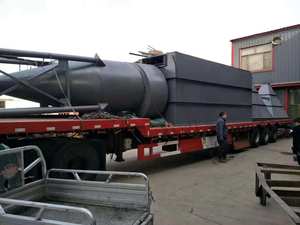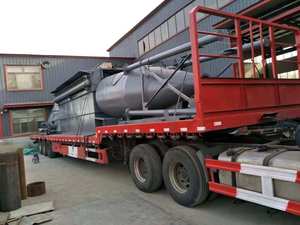
All categories
Featured selections
Trade Assurance
Buyer Central
Help Center
Get the app
Become a supplier

(99 products available)








































A multi cyclone separator, or multi-cyclone dust separator, is a small, dry, mechanical device used to separate particulate matter from flue gas. The separator comprises multiple cylindrical air conduits that utilize the centrifugal force created by high-velocity air routing to separate dust and other particles. The design of a multi-cyclone separator can vary depending on the application or the manufacturer's preference. Some common types are as follows.
Standard Multi-Cyclone Separators
Combined Separator/Filters
Multi-Cyclone Separator Cleanouts
Manual Cleanout
Automatic Cleanout
Vortex Separators
Standard multi-cyclone separators are the most commonly used separators in industrial settings. They usually come in large cylindrical-shaped bomboniere jars. A large amount of incoming air with particles then goes round and round in the individual cyclone 'jars.' The higher the speed, the more power it has to separate larger particles and drawbacks into the dust collector. The downside of a standard multi-cyclone separator is that smaller particles will remain in the air and can also be dusted off onto the clean side of the separator.
Some dust cyclone separators combine filter and separator functions. They usually come in a conical or cylindrical shape with a flat bottom. The filters inside these multi-cyclone separators usually comprise fabric bags that trap smaller dust particles, preventing them from going back into the environment. These kinds of separators are typically more expensive than standard ones due to bag costs and the need for regular filter bag changes.
Multi-cyclone separator cleanouts allow technicians to use wet/vacuum pressure cleaning; however, this is not a permanent fix. More debris will remain over time to be cleaned in the separator, requiring more frequent cleanouts and sometimes up to six months' service. The downside is that carrying out cyclones' manual cleanouts is more expensive than automatic solutions.
Automatic cleanout systems make it possible to clean the separator automatically while the system is running. This improves overall performance, but the downside is possible wear and tear on the equipment. The average cost of an automatic cleaning system is far less than the cost of a manual system.
While standard separators use centrifugal force to remove larger particles, vortex separators work on the same principle as cyclones. The air inlet is tangential to the circular separator, creating a whirling motion. The whirling motion then forces the particles to move toward the walls of the separator and drop into a collection drum or bin.
Maintaining the multi-cyclone air separator is essential to its working lifespan and efficiency. Some typical maintenance tips are as follows:
Due to their various benefits and characteristics, multi-cyclone separators have use scenarios in different fields.
Industrial processes
Multi-cyclone separators are widely used in industrial processes like oil refining, chemical manufacturing, and power generation. They separate valuable materials from mixtures, such as extracting crude oil from natural gas or separating solid catalysts from liquid reactants. In the power sector, they remove ash and dust from flue gases to protect downstream equipment and improve energy efficiency.
Environmental protection
Multi-cyclone separators play a vital role in environmental protection by treating industrial waste. They separate solid waste from liquid waste, allowing for proper disposal and reducing environmental pollution. In wastewater treatment plants, multi-cyclone separators recover sludge or solid waste for further processing, preventing contaminants from entering water bodies.
Food and beverage industry
In the food and beverage industry, multi-cyclone separators clarify fruit juices and oils. They remove solid impurities, fibers, and sediments, resulting in clear and high-quality final products. Additionally, multi-cyclone separators aid in juice recovery and optimize material utilization in food processing facilities.
Agriculture
Multi-cyclone separators are valuable tools in agriculture. They separate plant fibers, seeds, and other solids from processing liquids or vegetable extracts. This separation enhances the utilization of raw materials and reduces waste. Multi-cyclone separators contribute to sustainable agricultural practices and improve efficiency in agro-based industries.
When choosing a separator for a specific application, a few things have to be considered. The primary factors to consider when choosing a separator are the nature of the mixture to be separated, the desired end products, the separator's capacity, any available budget constraints, and installation and maintenance requirements.
A multi cyclone separator works best with a specific type of particles. When shopping for a separator, the type of particles that need to be separated should be the primary focus. Is the particle that needs to be separated fine or coarse? Is it dry (dust) or wet (slurry)? - Answering these questions can help determine the right cyclone separator.
The desired product after separation needs to be clearly defined. What type of air quality does one want? Does one want to reuse the material to be separated? The final product goals will help determine whether a cyclone or any other separator should be chosen. Or if some pre-treatment or post-treatment facility is required.
The separator's capacity depends on the volume or flow rate of the mixture that needs to be processed. This, in turn, determines the separator's size. One may have to settle for multiple separators if a large separator is not financially sensible. Or, a smaller separator might work if the mixture's flow rate is relatively low.
A cyclone separator may work technically but not fit financially. It's essential to know the budget when investing in a multi cyclone separator. Separators with more complex processes are typically more expensive. The installation, maintenance, and energy costs are also factored in.
An essential aspect of choosing a separator is its installation and maintenance requirements. Some separators need ancillary equipment, such as filters or fans, to work correctly. Others may need regular maintenance, like filter cleaning or replacing, which can be a cost over a time.
Q1: What is the difference between a cyclone separator and a multi-cyclone separator?
A1: The main difference is in their design and efficiency. A cyclone separator uses a single cylindrical unit to separate particles, while a multi-cyclone separator groups several smaller cylindrical units together. This parallel clustering enhances separation efficiency, especially for finer particles.
Q2: What are the advantages of a multi-cyclone separator?
A2: Multi-cyclone separators are more efficient than single-cyclone models. They occupy less space to achieve similar separation rates. Maintaining and cleaning multi-cyclone separators is often easier due to accessible grouping designs. They can process higher volumes of gas or air compared to single-cyclone models, making them suitable for industries with large-throughput demands.
Q3: What factors affect the performance of a multi-cyclone separator?
A3: The separator's height-diameter ratio, feed velocity, temperature, pressure, particle size distribution, concentration of particles, and the design of the multi-cyclone separator (number of units, their dimensions, etc.) also play a crucial role.)
Q4: How much dust does a multi-cyclone separator collect?
A4: A multi-cyclone dust collector typically works at an approx 85% efficiency rate, meaning around 15% of the dust circulates within the baghouse. Nonetheless, this can translate to a significant quantity of dust, given the air volume processed by the collector.